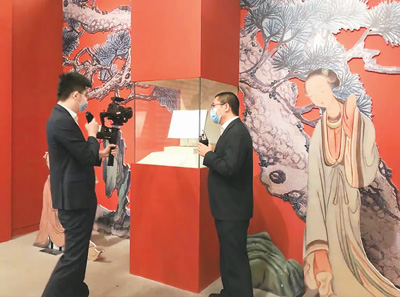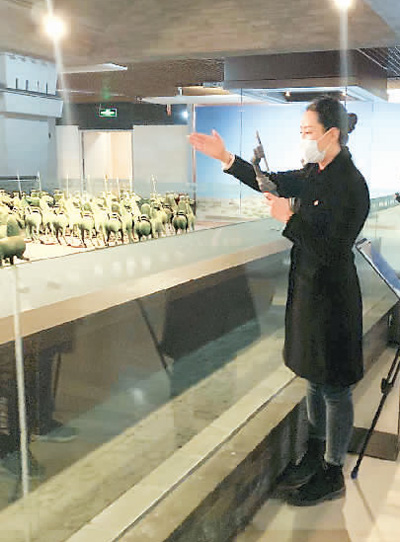

On March 14, Bai Xuesong, a guide at the Beilin Museum in Xi’an, northwest China’s Shaanxi province, hosted a live broadcast showcasing the collections at the museum, which attracted over 300,000 viewers.

Bai Xuesong works at the Beilin Museum (Photo provided by Bai Xuesong)
Bai has become a hit on the Internet ever since he started giving tours of the museum collections through live streaming videos on Feb. 23. After viewing his broadcasts, many netizens expressed a desire to visit the museum when it reopens after the epidemic.
Furthermore, the number of fans of the official online store of the museum on the e-commerce platform Taobao has grown to 25,000, with sales of related products seeing a huge increase.
It is estimated that more than 30 museums in China, including the National Museum of China and the Dunhuang Academy China, have hosted live broadcasts on online platforms amid the epidemic, each gaining over 10 million views in one day.

Live streaming at the National Museum of China (Photo via Taobao.com)
The Gansu Provincial Museum, one of the museums that have been exploring online platforms, attracted as many as 900,000 viewers at one point in its live broadcasts, more than half of its total viewers last year, according to Shi Ce, deputy curator of the museum.

Live streamingat the Gansu Provincial Museum (Photo viaTaobao.com)
Cooperation between museums and Internet platforms is beneficial to both sides, said Huang Yang, vice professor with the cultural heritage and museology department of the Nanjing Normal University. Huang explained that while museums need to use live broadcasts to spread culture, Internet giants need the resources that museums possess to provide high-quality content for users.
 Fire brigade in Shanghai holds group wedding
Fire brigade in Shanghai holds group wedding Tourists enjoy ice sculptures in Datan Town, north China
Tourists enjoy ice sculptures in Datan Town, north China Sunset scenery of Dayan Pagoda in Xi'an
Sunset scenery of Dayan Pagoda in Xi'an Tourists have fun at scenic spot in Nanlong Town, NW China
Tourists have fun at scenic spot in Nanlong Town, NW China Harbin attracts tourists by making best use of ice in winter
Harbin attracts tourists by making best use of ice in winter In pics: FIS Alpine Ski Women's World Cup Slalom
In pics: FIS Alpine Ski Women's World Cup Slalom Black-necked cranes rest at reservoir in Lhunzhub County, Lhasa
Black-necked cranes rest at reservoir in Lhunzhub County, Lhasa China's FAST telescope will be available to foreign scientists in April
China's FAST telescope will be available to foreign scientists in April "She power" plays indispensable role in poverty alleviation
"She power" plays indispensable role in poverty alleviation Top 10 world news events of People's Daily in 2020
Top 10 world news events of People's Daily in 2020 Top 10 China news events of People's Daily in 2020
Top 10 China news events of People's Daily in 2020 Top 10 media buzzwords of 2020
Top 10 media buzzwords of 2020 Year-ender:10 major tourism stories of 2020
Year-ender:10 major tourism stories of 2020 No interference in Venezuelan issues
No interference in Venezuelan issues
 Biz prepares for trade spat
Biz prepares for trade spat
 Broadcasting Continent
Broadcasting Continent Australia wins Chinese CEOs as US loses
Australia wins Chinese CEOs as US loses